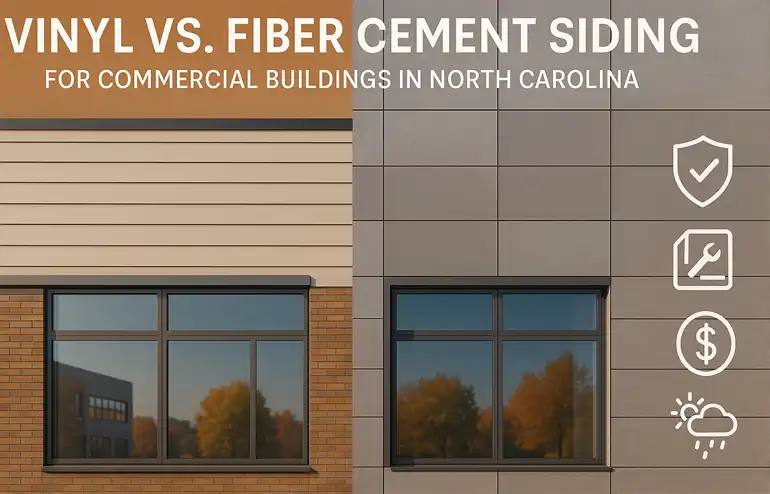
Oct
Vinyl vs. Fiber Cement Siding for Commercial Buildings in NC
If you own a commercial building in North Carolina and need new siding, it’s wise to consider a material that balances cost, durability, maintenance, and aesthetics. You also need a material that performs well in this climate, which features extremes ranging from heat and humidity to cold and rain. Thus, the siding you choose needs to be able to stand up to moisture and heat stress so it can last its intended service life.
Today we will compare vinyl siding and fiber cement siding for commercial use in NC. Still unsure? Consult with your trusted siding contractor in North Carolina for more advice and guidance.
Climate Compatibility and Performance
Vinyl Siding
This plastic-based siding material resists moisture absorption and will not rot under humid conditions. That being said, it’s more prone to warping or softening when installed too close to high temperature sources. In extreme UV exposure, the color of your siding can fade over time; in extreme cold, it can get brittle and crack under impact.
Fiber Cement Siding
This material is made from cement, sand, and cellulose fibers. It offers more dimensional stability, resisting warping, shrinking, or swelling under heat or humidity. Plus, it doesn’t fade in the face of UV rays, especially when it’s been factory finished with quality coatings. This non-combustible material also resists pests such as termites.
In general, fiber cement handles heat, humidity, storms, and UV stress in North Carolina better than vinyl in the long run.
Longevity and Durability
Vinyl Siding
Vinyl siding can last between 20 and 30 years with good maintenance. Higher-end vinyl profiles and insulated vinyl can last longer. However, exposure to hail, thermal cycling, or impact damage can detract from service life.
Fiber Cement Siding
Fiber cement siding can last between 30 and 50 years with proper installation and upkeep. It can withstand the effects of storms, impacts, termites, and fire. Due to its thicker and more robust construction, it can resist wear even under commercial conditions.
If you’re looking to minimize rework and need reliable durability for your commercial building, fiber cement is a good long-term solution.
Maintenance and Upkeep
Vinyl Siding
Vinyl is low maintenance, which is a big benefit. All you need to clean it is some soap and water. It never needs to be repainted. Plus, the pigment of vinyl goes all the way through.
Fiber Cement Siding
This material requires more care, such as repainting every 10–15 years and occasional caulking. But due to its robust structure, maintenance tasks are more cosmetic than structural.
In commercial settings where maintenance costs could be high, vinyl is a cost efficient choice.
Installation, Weight and Labor
Vinyl Siding
Lightweight and easy to install, vinyl siding comes with lower labor costs. And because panels are easier to handle and cut, vinyl is conducive to larger facades.
Fiber Cement Siding
Heavier and more labor-intensive to install, fiber cement generates silica dust when cut, requiring contractors to take safety precautions and use specialized tools – both of which increase cost and complexity.
If you opt for fiber cement, you will have to plan for these extra costs when siding your commercial building.
Aesthetic and Architectural Flexibility
Vinyl Siding
While vinyl boasts a wide range of colors and textures, it may appear more “manufactured” than other materials. Color changes may require full panel replacement.
Fiber Cement Siding
With the ability to mimic wood, stucco, or other high-end siding styles, fiber cement can easily be repainted. It brings an upscale look and design versatility as well.
If you prioritize architectural appearance and brand impression, such as for the retail, office, and hospitality industries, fiber cement would be the way to go.
Cost and Return on Investment
Vinyl Siding
Vinyl’s upfront costs for material and labor are lower.
Fiber Cement Siding
Fiber cement costs more outright but has a longer lifespan. If you’re looking for a strong long-term ROI for your commercial building, fiber cement would be a better option.
In the end, fiber cement siding generally outperforms vinyl in terms of durability, climate resilience, aesthetic flexibility, and long-term value for commercial buildings in North Carolina. However, vinyl still has a place for budget-conscious components or auxiliary structures.
Contact Redeem Roofing
Need more guidance on which siding to choose? Contact us for a free quote and consultation today.
Quality work at a fair price while providing phenomenal customer service. Redeem roofing just put a beautiful, brand new roof on my home and I couldn't be happier with the quality of their work or their commitment to customer satisfaction. Bahnson E
- Category: Roofing
